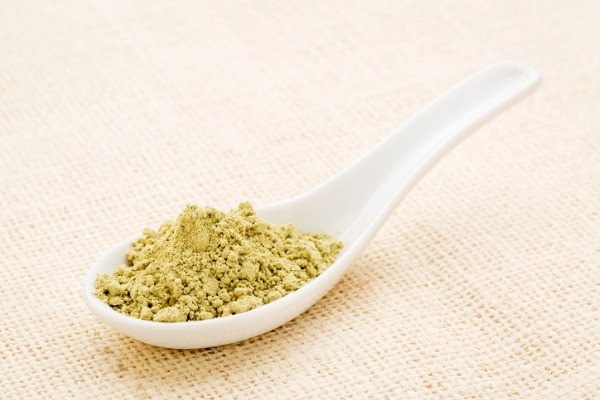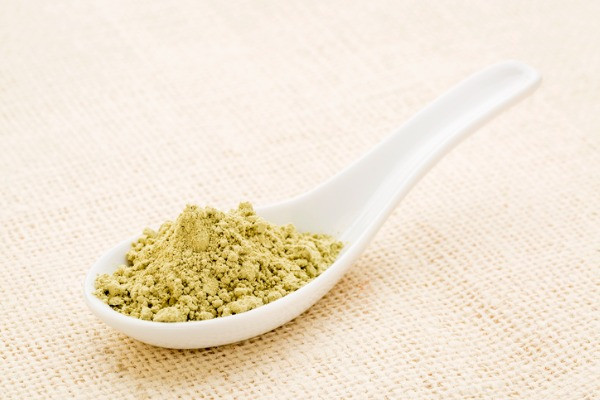Like Irish Moss, Kelp or Bladderwrack is a fantastic aquatic plant or algae to include in your pet’s raw food diet. If you can give it fresh all the better, but if not then dried flakes are the next best thing. So long as the kelp or Bladderwrack (Fucus vesiculous) is from a clean source and hasn’t been mixed with other algae that could be toxic to your cat or dog,
In Asia seaweeds have been used as both medicine and food for a very long time and given the level of toxicities our pets are exposed to daily, adding some form of sea vegetable to your pet’s diet goes a long way to preventative medicine. Kelp is a great source of organic minerals for the body that helps stimulate the immune and lymph system that also binds to metal pollutants to help them be eliminated through faeces.
Kelp like Irish Moss can help with a number of disorders in pets. For example, Kelp is known to help with the thyroid gland especially for those animals with a poorly functioning thyroid. It’s known for its ability to help with rheumatic conditions, is an anti-viral and anti-HIV. In TCM kelp is considered to have a therapeutic element linked to the spleen and stomach which can help clear heat and tonify yin.
Ensure your Kelp is sourced from those sea areas with low pollution and if buying in a powder form, that the products have been properly tested for contaminants and heavy metals etc. as the quality of the kelp is crucial to the healing of your pet.
Benefits of Kelp
- Anti-viral
- Anti-arthritic
- Anti-inflammatory
- Can be effective in the treatment of HIV
- Helps eliminate the toxicities from radiation and chemotherapy
- Helps protect against environmental pollutants
- Supports the digestive, immune and nervous system
- Supports the endocrine and cardiovascular system
- Helps with thyroid disorders
- Aids the healing of ulcers throughout the body, such as colitis, gastric and duodenal ulcers
- Assimulates nutrients in the bloodstream for good health
- Increases vitality
- Aids remineralising of the body
- Can help with either losing or gaining weight through the regulation of the thyroid
- Cancer-fighting agent
- Helps repair damaged cells through its ability to stimulate the thyroid
- Promotes fertility
- Helps eye health
- Helps prevent osteoporosis
- Helps with prostate disorders
- Loaded with minerals and vitamins and fibre
- Great antioxidant
- Helps with constipation
- Great to help with detoxification
- The saltiness helps reduce abdominal swelling and pain
- Helps with reducing the effects of allergies
Is Kelp Safe for Pets?
Yes. Kelp is very safe for cats and dogs and can be added daily to your pet’s diet. It’s really great for those cats and dogs that are mineral deficient. However, as with everything, it will come down to the quality of the kelp.
There are a lot of poor quality kelps out there so make sure you’ve done your research to know the kelp is harvested with minimum contaminations and is harvested sustainably. Also that you’re aware of the iodine content, so you can adjust the amount you give to your cat and dog depending on the level of iodine in the kelp as there is a lot of variations between the products on the market.
Ensure there are no contraindications with any medication. If feeding fresh, soak the kelp to remove a lot of the salt content and to make it more appetizing for your cat and dog.
Remember a little goes a long way as you do not want to exceed your pet’s RDA for iodine as kelp is bursting with iodine and feeding too much can have a negative impact on their health.
Side Effects
If your pet’s condition worsens or does not improve speak with your integrative vet.
Precautions should be taken with animals with Hyperthyroidism, have blood pressure issues, suffer from skin eruptions, have kidney issues etc. or speak to your vet to see how you can incorporate kelp into your pet’s diet to help them heal and move away from medications
Check with your holistic vet if your pets are on medication for thyroid or have insulin issues before adding kelp to your pet’s diet.
Do not overfeed as the level of iodine found in kelp could long term halt healthy thyroid activity. A little goes a long way.
If given too much, your pet may suffer vomiting and diarrhoea

How to Give Kelp to Cats & Dogs
Forms of use:
- Fresh
- Powder
- Dried flakes
Administration can be via
- Added directly to food
- Given as a fresh treat
- Given in powder form, mixed with food
- Can be used topically
Kelp Dosage for Pets
Cats & Dogs
Bladderwrack is a good all-around seaweed especially considering most pets are iodine deficient. Cats on a complete raw diet don’t really need seaweeds added to their diet daily. But on occasion, you could use kelp as a tasty snack or mix it in with their food to maintain healthy mineral levels. Kelp is an excellent health supplement, especially in ensuring your cat or dog have access to trace minerals and vitamins that are so often missing from a pet’s diet.
If you want to use medicinal seaweeds such as Kelp, Dulse or Irish Moss to help your pet’s health issue then consult with your integrative or holistic vet to see how it can be incorporated into your pet’s diet to support your pet’s individual health needs and ensure healing occurs.
General-purpose guidelines; Use in rotation with other sea vegetables such as Nori, Irish Moss, Dulse and sea lettuce. Always know the source of the product and its origin. Ensure you don’t buy from coastal areas that are known to be polluted or contaminated as your pet will absorb any toxicities.
Remember, less is more and don’t underestimate the importance of rotating the sea vegetables you give to your pet. So many pet owners get fixated on one or two ingredients and feed it forever and a day. The more seasonal feeding you do and the more you change in and out ingredients, the more complete your pet’s access is to a range of vitamins and minerals and also the more diverse their gut microbiome is for optimal health. Always work in harmony with your pet’s body, not against it.
If you’re adding this daily put a small sprinkle in with your pet’s food or use just a pinch worth. Kelp is also great when added to bone broths to help your pet heal.
Fresh. As with Irish Moss, If you’re harvesting this directly from the sea please be respectful of the molluscs, sea snails etc. that may be grazing on the kelp. Please ensure you leave them in their natural habitat before you walk off with your harvest. Equally never take more than you need. Kelp is an important part of a delicate ecosystem that should be fully respected.
Using cold or room temperature water (not hot) thoroughly wash to remove any sediment. Once cleaned, soak in cold water to reduce the saltiness as much as possible, then run cold water through it a few times before feeding this to your pet. You can cut your kelp up into small pieces to sprinkle over the food or give a piece to your pet to play and chew on. It will be a tasty healthy treat or snack and many animals love the texture to play with before eating. Don’t overfeed kelp to your pet or you’ll likely give your pet an upset stomach.
Dried. Go through the cleaning process as described under ‘fresh’ then you can dry the Bladderwrack in the sun, or with a dehydrator, or let it dry at room temperature so it becomes crumbly and flakey when you rub it between your fingers and thumb. Put an amount into a herb shaker to sprinkle on your pet’s food and store any remaining in an airtight container, in a cool dark place. Use as needed.
Making a Gel. You can use fresh or dried kelp. If you’re using dried kelp use about 1/4 cup of flakes to 1 cup of clean water. Let the flakes soak for 12 to 24 hours so the liquid is a deep brown/reddish colour. Strain off the liquid into a jar. The consistency of the gel will depend on how much water you use. For a thicker gel use less water. This will keep in the fridge for about a week to 10 days.
From fresh; Clean the kelp as described under ‘fresh’ then depending on how much gel you want to make you’ll need a 1:1 ratio of Bladderwrack and clean water. For example, half a cup of kelp to half a cup of water. Place both into a blender and blend until it has a smoothie/gel-like consistency.
Avoid using the blender for too long as you don’t want the moss to become heated because of the blending motion. Pop your homemade gel in a jar and keep it in the fridge for up to three to four weeks depending on the quantity of gel you’ve made. You can apply this gel directly onto your pet’s irritated skin. Or add it into an ice cube tray to give as a treat on warm days.
A great option if you can with your 1:1 ratio is to combine half Bladderwrack with half Irish Moss (or other healing seaweed) to 1 cup of water. Make your gel as described above but using both seaweeds. This can be applied to irritated skin or you can pop a 1/4 to 1/2 a teaspoon of this jelly in with your pet’s food, or feed it directly. This combined mix is an extremely potent healing potion so go slow if you’re feeding this to your pet and only feed for a few days, or every other day for up to a week. Do not feed this combined gel to your pet for any length of time. It would be for a quick burst of time and then continue with either Irish Moss or fresh, powdered or dried kelp flakes.
Equally, if you want to use the gel as a body cream you can add some with coconut oil to spread through your pet’s fur. This is especially good if your cat or dog has patchy fur or problems with their skin.
Powder: Follow the steps for ‘Fresh’ and then ‘Dried’, then using a pestle and mortar or a pulverizing herb grinder, grind the dry sea moss into a fine powder.
Fresh is best when you’re using sea vegetables as the nutritional value is at its highest level. If you make small batches your pet will benefit from the nutrition and you’ll not be left with a large amount that goes off in the fridge. If for any reason it does go off, seaweed makes a great fertilizer for your plants so don’t bin it just because it’s no longer fresh enough for yourself or your pet. Feed it to your flowers, they’ll love you for it!

